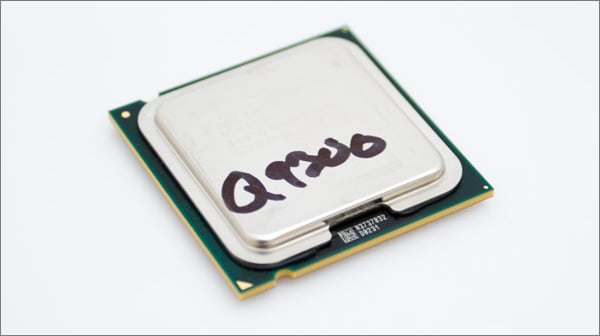Intel Core 2 Quad Q9300 Processor
Overview and Specifications
Intel’s Core 2 Quad Q9300 has some rather large shoes to fill. This newly shipping, relatively low-cost (~$270) quad-core processor from Intel is a replacement for their long-standing price to performance champ, the Core 2 Quad Q6600. The Q6600 was the first quad-core in Intel’s arsenal which was actually affordable, and even today, it remains one of the best values on the market. Not only is the Core 2 Quad Q6600 inexpensive for a quad-core at around $230, but it is extremely overclockable and provides a significant amount of computing power for the dollar. Core 2 Quad Q6600’s are still in high-demand – a trend which is likely to continue until Intel physically removes from them from the market.
Like we said, rather large shoes to fill. Luckily, the Core 2 Quad Q9300 processor has some impressive new features under the hood along with a higher clock speed, all at a similar price point as the Q6600. As the Core 2 Quad Q9300 utilizes Intel’s new 45nm manufacturing technology (as opposed to 65nm of the Q6600), potential buyers will be expecting the Q9300 to perform better and produce less heat compared to its predecessor – certainly a difficult task but one which we believe Intel can meet. We’ve already seen what Intel’s 45nm manufacturing technology is capable of with its dual-core “Wolfdale” architecture, and if Intel can bring the same benefits to the quad-core market as it did for dual-cores with “Wolfdale”, Intel will be in good shape.
The Q9300 is coming to market at an interesting time. Intel has struggled somewhat to get their mainstream 45nm quad-core components on to market, and the Core 2 Quad Q9300 represents Intel’s first real attempt at holding on to the low-cost quad-core market against a newly resilient AMD. With AMD’s new lineup of quad-core Phenom X4 B3 processors bringing similar features at a lower price point than the Q9300, Intel may have to work a little harder in order to make the Q9300 a success. Let's see if they're up for the challenge.

Intel's Core 2 Quad Q9300 Engineering Sample
| |
 Core 2 Quad Q9300 - Top |
 Core 2 Quad Q9300 - Bottom |
This Core 2 Quad processor, as we mentioned before, is based on Intel’s 45nm “Yorkfield” architecture, which replaces their 65nm Kentsfield designs that dominated Intel’s product lineup throughout 2007 and most of early 2008. The “Yorkfield” architecture is, more or less, two 45nm “Wolfdale” cores connected together into a single chip design. The Core 2 Quad Q9300 is not a native quad-core like AMD’s Phenom processor, but rather is two dual-cores connected under a single heat spreader - a multi-chip module. As our tests have shown in the past, this does not affect performance in any real way, and shouldn’t be a consideration when thinking of buying one of these chips. However, it is just an interesting aspect to note, from a technology perspective.
The Q9300 is somewhat of an anomaly as it’s the only member of the Core 2 Quad 45nm family which has 6 MB of L2 cache (2 x 3 MB cache per dual-core die). All other members of the Core 2 Quad family have a double-sized 12 MB of cache, which will give an estimated 5-10% performance boost at the same clock speed compared to the 6 MB variants. Interestingly enough, with 6 MB of L2 cache, the Q9300 actually has less cache compared to its predecessor (the Q6600), which had 8 MB of L2 cache (2 x 4 MB). However, cache latencies have improved with the new architecture, so performance will not suffer greatly due to this design decision. We do find it strange that Intel is introducing only one model based with 6 MB of cache, although it's certainly possible that Intel will be introducing newer models to fit alongside this chip in the future.
While the Q9300 takes a hit on cache, its architecture is improved just about everywhere else. The Q9300 runs at a clock speed of 2.5 GHz with a front side bus speed of 1333 MHz (compare to the Q6600 at 2.4 GHz @ 1066 MHz FSB). In addition, the Q9300 supports Intel’s new SSE 4.1 instruction set, which unlike any other SSE release we’ve seen in the past, can offer huge performance increases with properly coded applications. The biggest benefactor of this new instruction set have been video encoding applications, which can see massive (30%+) performance gains with SSE 4.1 supported processors.
Even with all these new features under the hood, the Core 2 Quad Q9300 runs on a standard Socket-775 interface and is compatible with the vast majority of Socket-775 motherboards on the market today. Most motherboards require a BIOS update in order to see the proper CPUID’s of these new processors, but if your motherboard supports 45nm, 1333 MHz FSB processors, you’ll likely be able to run one of these new chips. The Q9300 has a TDP (thermal design power) rating of 95W, which means you likely won’t have to replace your existing cooler, either. However, if you buy a retail boxed processor, you’ll get one of Intel’s (decent) retail cooling systems. For our tests, we’ll be using something a little bigger – after all, we want to see what this chip is capable of without cooling being a limitation.






